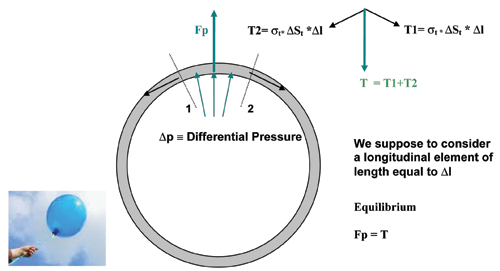4. A flight at high altitude
4.1 Life inside the airplane cabin and cockpit
Modern airplane with jet propulsion flies at a cruise altitude between 8000 and 11000 m. At that altitude the pressure is about 1/3 than at sea level and the temperature is about – 40 °C. These conditions inside the cabin and cockpit the life for passengers and crew not possible . To solve that problem air is spilled out from engine and conditioned to allow living.
4.2 How works a pressurized fuselage structure ?
To allow life inside the cabin/cockpit there is a very high pressure difference between the internal and external skin of the fuselage when flying at high altitude. So the skin has to be designed to withstand this differential pressure.
4.3 How the fuselage skin withstands forces due to differential pressure

The resultant pressure force Fp is acting on fuselage skin element 1-2, with a thickness ?St , . This pressure force is balanced by the resultant of internal traction force that the skin external to that element does exert on it. It works as an inflated balloon. When a balloon flows up away the internal thermodynamic pressure is more and more greater than the atmosphere static pressure (decreasing with altitude), and at the end the balloon explodes.
4.4 Ice problem

Experimental and numerical applied research on ice problems in Air Transport Airplane
We are used to think that water turn to ice at 0°C, but this is only true at sea level and inside the freezer. If the atmosphere pressure is less than at sea level, the water is very clean it is still liquid even at temperatures very lower than zero. The clouds are made either of little ice crystal or (more often) of very small water droplets. In this case they are not transformed in ice because the two above explanations.
If an airplane meets a water cloud, the water freeze on the wing surfaces instantly, or on some other parts of the airplane (both acting as condensation nuclei).
The ice on the wing produces a degradation of aerodynamic characteristics of the wing and can cause a critical stall condition or a loss of control capability. The ice on engine inlets can cause a flame out of the engine or even an engine explosion.
The ice accretion is also dangerous for some important probe instrumentation as anemometer, altimeterter, etc...
The solve the problem, modern aeronautic technology utilises de-icing systems : the ice does form but the deicing system breaks it down; in other cases heat sources are utilized anti-icing system, in this case the ice does not form at all. The anti-icing system is normally used for engine inlet or for probe instrumentation. Applied Researches are going all over the world to improve the ice accretion knowledge and protection on Air Accretion and Protection.

Cube ice at sea level

Cirrus clouds are made of ice crystals

Water clouds
That research involves:
- Ice Wind Tunnel Simulating the flight at actual ice accretion condition;
- improving on design of anti-icing and de-acing systems;
- better knowledge of meteorological condition related to the occurrence;
- improvement of the procedures in ice condition flight;
- Improvement on numerical tools to understanding ice accretion on an airplanes









